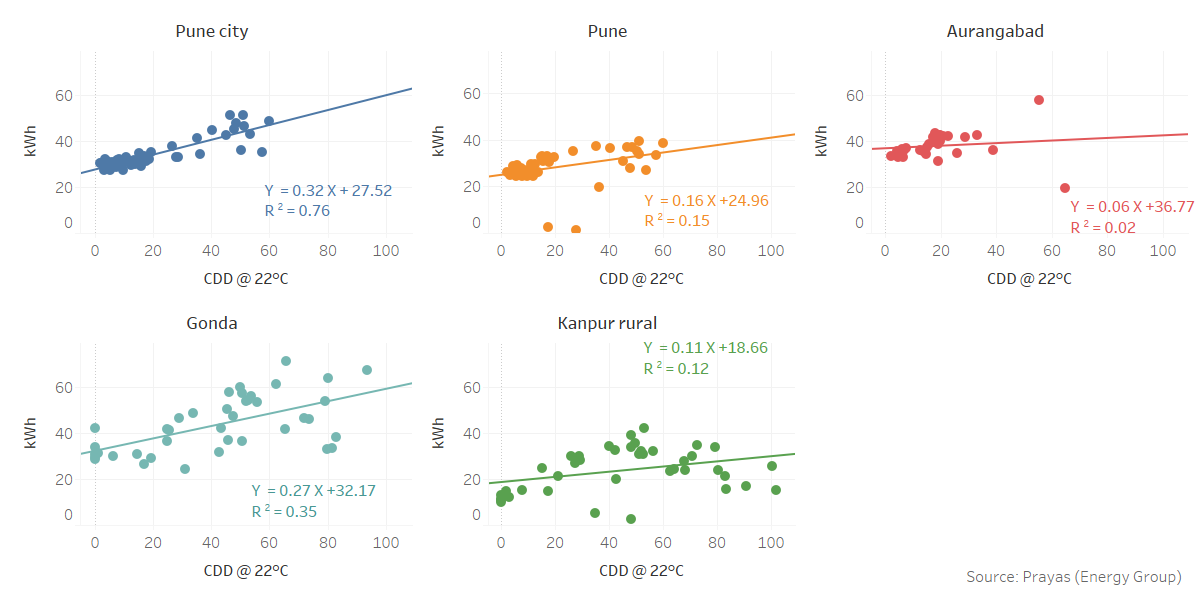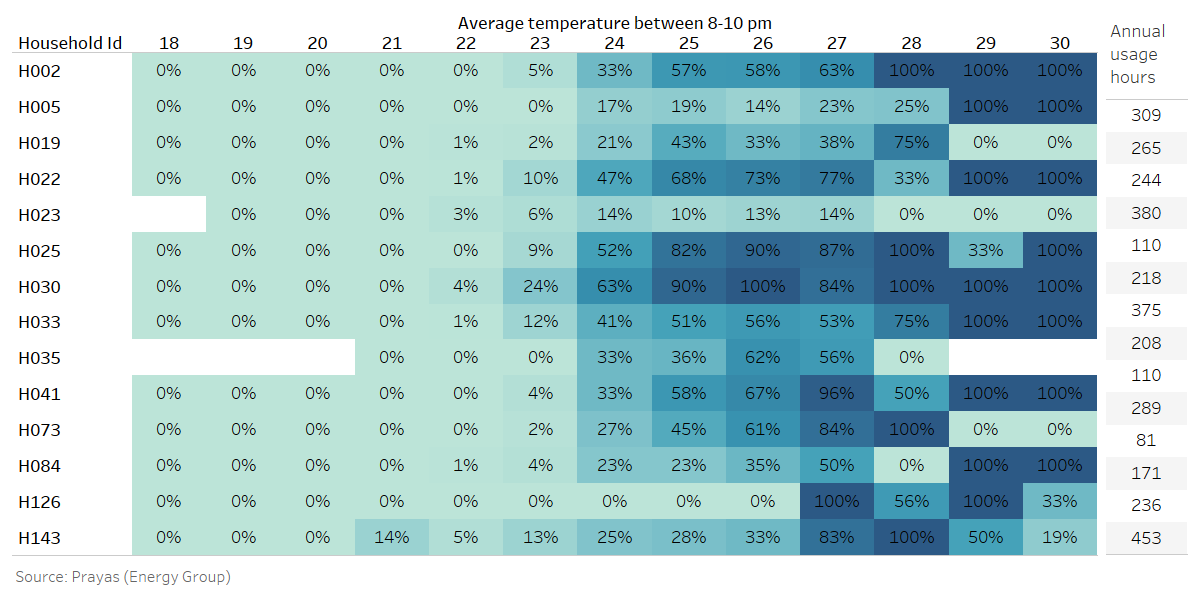
Insights from smart metering data
eMARC is an initiative by Prayas (Energy Group) to provide insights on electricity consumption in Indian homes. Under eMARC, minute-wise data related to electricity consumption is collected using smart meters from a sample of households and appliances. Interactive dashboards based on the analysis of this data are available on the eMARC website. In this blog series we present key observations based on the data collected from 115 households from January 2018 to June 2020. The households include urban households from Pune City and semi-urban and rural households from the districts of Pune, Aurangabad, Kanpur Rural, and Gonda. In this post we present the insights on the impact of temperature on electricity consumption patterns of the sample households.
Please read this post for details on how emarc works and the description of our sample.
Key Takeaways
- A strong correlation between electricity consumption and temperature is observed in the households in Pune city. The relationship is weak in semi-urban and rural areas.
- Air-conditioner usage patterns vary significantly. The total usage hours for households in Pune city varied between 80 to 450 hours per year.
- Although, no clear threshold temperature at which households switch-on their air-conditioners, higher probability at temperatures above 28°C.
Ambient temperature is one of the key factors driving a household's electricity consumption. Space-cooling appliances like ceiling fans, air-coolers, and air-conditioners can consume substantial electricity. In this post, we examine the relationship between the household’s electricity consumption and ambient temperature in the eMARC sample. We also focus on the usage patterns of the air-conditioners in our sample households as their contribution to the total electricity consumption is significantly high. We limit our analyses to the ambient temperature and do not consider other weather related factors like humidity and building type features. We also do not consider space-heating appliances as we see very limited use of these appliances in our sample.
We use the common concept of cooling degree days (CDD) as an indicator of the household’s need for space cooling. CDD are a measure of how much (in degrees), and for how long (in days), the outside air temperature is above a certain level (reference temperature). It is calculated as the difference between the average of maximum and minimum temperature of a day and the reference temperature. We consider a reference temperature of 22°C. As the households use a mix of space-cooling appliances, we consider a comparatively lower temperature at which a household may switch on their ceiling fans at lower speed. Air-conditioners, on the other hand, are switched on at much higher temperatures as we will discuss later.
| Region | CDD @ 22°C in 2019 |
| Pune city | 1,057 |
| Pune | 1,057 |
| Aurangabad | 1,497 |
| Kanpur rural | 1,844 |
| Gonda | 1,729 |
Table 1: Cooling degree days in 2019 for different regions at 22°Celsius reference temperature
Temperature and Electricity Consumption
Figure 1 shows the correlation between the weekly electricity consumption of the households and the cooling degree days for different households of the sample in different regions. As can be seen, electricity consumption significantly increases with temperature in Pune city. The slope of the trend-line is the highest with a high value of R2 (suggesting a better fit). The slope and the R2 value further increased in households with air-conditioners. However, this behaviour is not observed in the other regions. Although the electricity consumption does increase with the temperature, a weaker correlation is observed in the semi-urban and rural areas.

Figure 1: Temperature and Electricity Consumption
Air-conditioner usage pattern
We examine the air-conditioner usage pattern of the 14 households in our sample in Pune city in little more detail. We did not install a separate meter on air-conditioners but we identified the switch-on and switch-off patterns using the main-line load pattern by identifying sustained high loads corresponding to air-conditioners. We find that people use ACs only during the summer months in Pune city. The total usage hours vary between 80 to 450 hours per year across the households. The Bureau of Energy Efficiency (BEE) considers annual usage hours of 1600 hours for its calculations to estimate savings from star-rated appliances. We also find that most of the households use ACs only during the night. However, as can be seen in Figure 2, there is significant variation across the households in the AC usage pattern on one typical summer day.

Figure 2: AC usage pattern of the households on one summer day
We also observe that there is no clear reference temperature at which people switch on their ACs. As can be seen in Figure 3, it changes across the households. Even the same household may respond differently to the same temperature. Apart from individual household behaviour, we also observe two broad patterns. Temperature fluctuations in preceding days may result in people not switching on their ACs even at temperatures they usually do. For instance, people may not switch on their AC at 30°C, if there have been temperature fluctuations in preceding days. On the other hand, they may switch on the ACs if the ambient temperature has been consistently 28°C. Similarly, people usually do not switch on their ACs in the months of February and early March even if there are occasional high temperature days. However, we do observe that chances of households switching their AC on is higher with night time (8-10pm) temperature higher than 28°C.

Figure 3: AC usage at different temperatures
To conclude, we see a significant heterogeneity in households' response to the temperature. In Pune city, the correlation between the temperature and electricity consumption is stronger than those in the semi-urban and rural regions of Maharashtra and Uttar Pradesh. The correlation is stronger in households with air-conditioners. We also observe variation in the AC usage patterns in Pune city. The total usage hours vary between 80 to 450 hours per year across the households. Although there is no clear threshold temperature at which households switch on their AC, we observe that the chances of an air-conditioner being switched-on is higher at temperatures above 28°C. Deeper insights like these on the relationship between temperature and electricity consumption, particularly related to air-conditioners, from high resolution smart meter data can be crucial for forecasting demand as well as designing demand response programmes.
Contributors: Aditya Chunekar, Abhiram Sahasrabudhe, Shweta Kulkarni
Please contact Aditya Chunekar (
Suggested Citation: Prayas (Energy Group), ‘Temperature and Electricity Consumption Patterns’, part of blog-series on smart meter data collected under the eMARC initiative, July 2021.
Please click here to read the other posts in this series.

